智能监控(监控大盘)
最后更新时间:2025-07-29 16:53:21
DBbrain 支持自定义监控大盘,满足用户多实例、多指标监控视图的关联对比查看。
说明:
监控大盘目前支持云数据库 MySQL(不含单节点 - 基础型)、云原生数据库 TDSQL-C(TDSQL-C for MySQL)、腾讯云数据库 MariaDB、腾讯云数据库 TDSQL MySQL、云数据库 Redis、云数据库 MongoDB、自建数据库 MySQL。
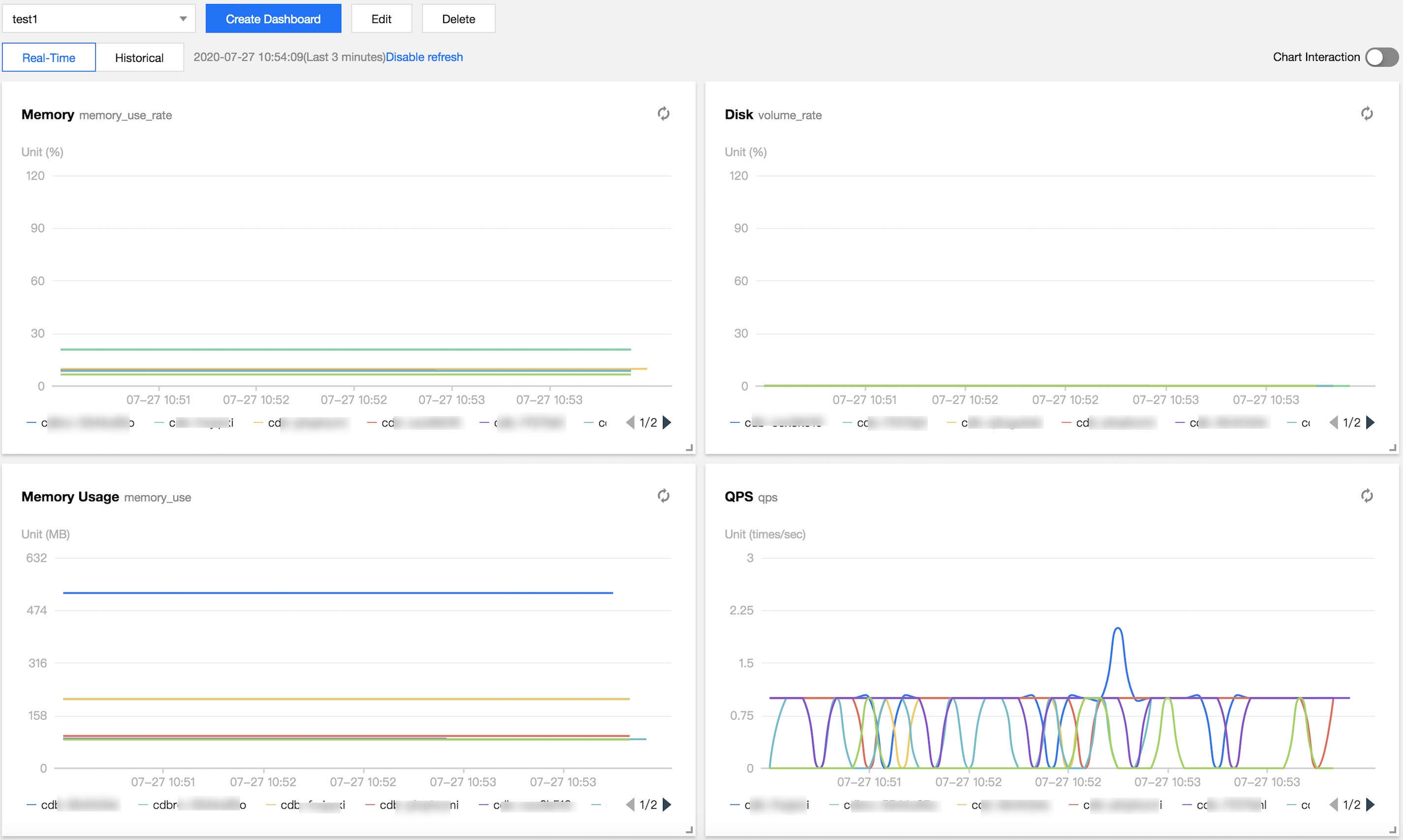

新建大盘
1. 登录 DBbrain 控制台。
2. 在左侧导航选择监控告警 > 智能监控。
3. 在上方选择数据库类型。
4. 选择监控大盘页签。
5. 单击新建大盘,输入大盘名称,选择需要对比的监控指标并添加监控实例后,单击保存,即可完成监控大盘的建立。
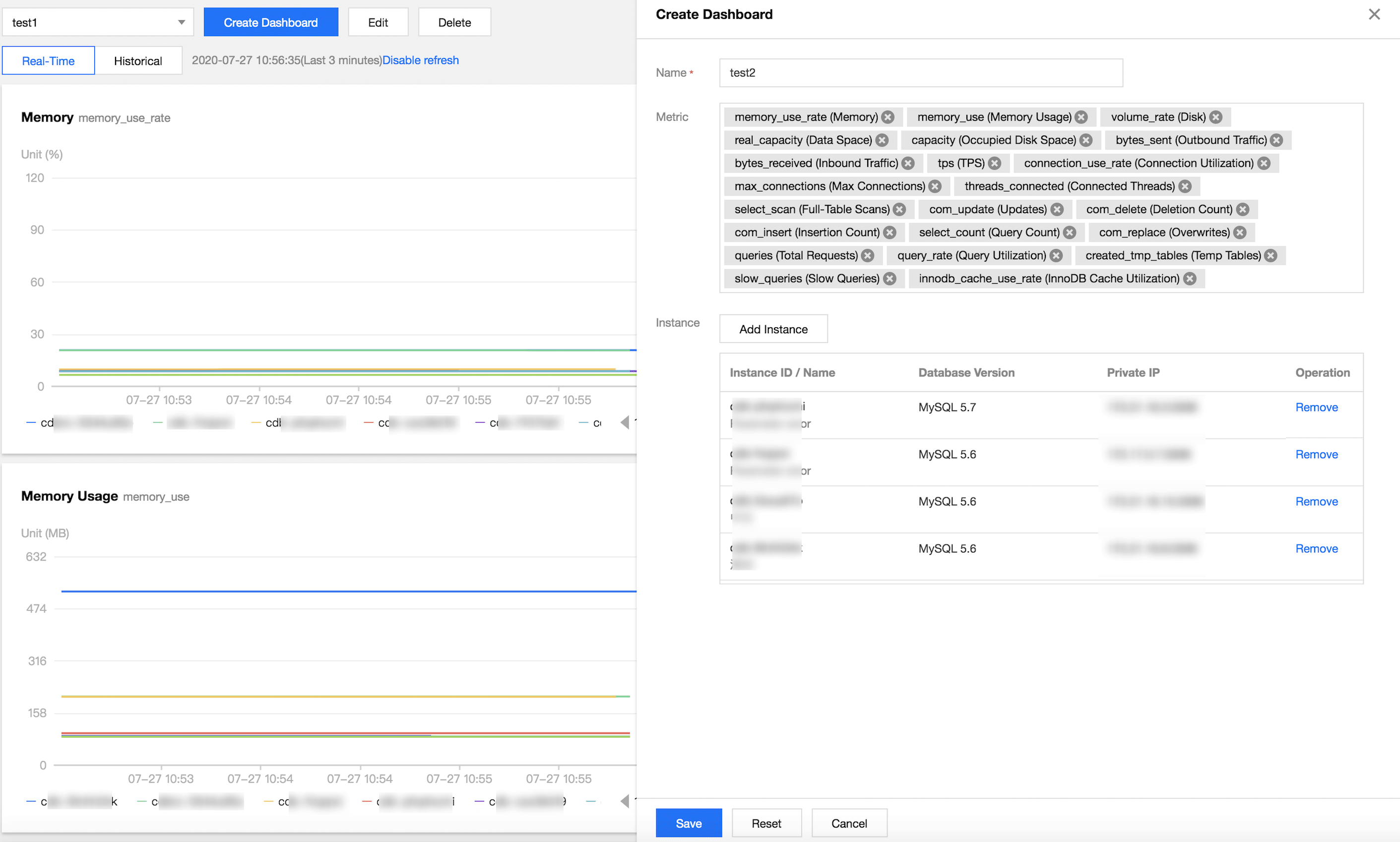
查找/编辑/删除大盘
1. 登录 DBbrain 控制台。
2. 在左侧导航选择监控告警 > 智能监控。
3. 在上方选择数据库类型。
4. 选择监控大盘页签。
5. 单击大盘名称的下拉框,切换查看不同的监控大盘。
单击编辑当前大盘,即可对当前大盘的监控指标与监控实例进行修改。
单击删除当前大盘,即可删除当前大盘。
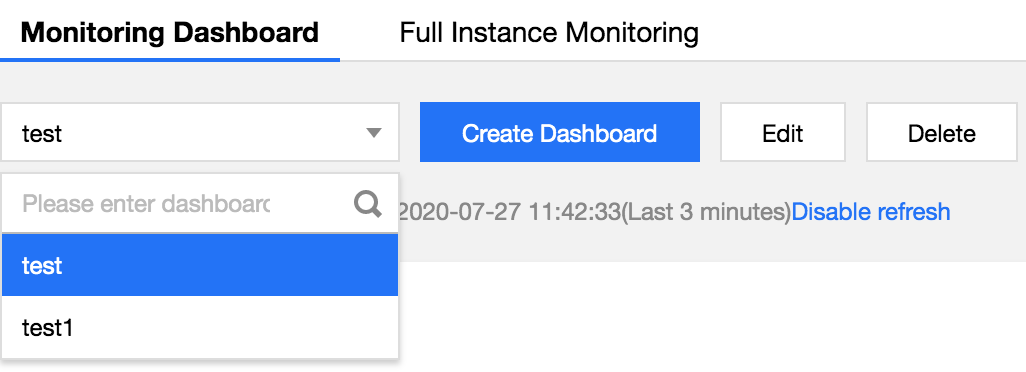
查看大盘详情
1. 登录 DBbrain 控制台。
2. 在左侧导航选择监控告警 > 智能监控。
3. 在上方选择数据库类型。
4. 选择监控大盘页签。
5. 选择待查看的大盘名称、选择查看实时或历史数据。
实时:用户可以查看近三分钟的实例性能指标对比情况,默认情况下为自动刷新,单击停止刷新可停止实时刷新监控。
历史:选择不同的时间段,可显示所选时间段内的监控大盘视图,支持近1小时、近3小时、近24小时、近7天以及自定义时间的切换查看。
6. 查看大盘监控指标。
监控大盘支持图表联动和切换单列/双列显示模式。
开启图表联动
在页面右上方打开图表联动开关,可以查看多实例、多指标监控视图的关联对比。 鼠标悬浮在任一趋势图上的数据点,其他趋势图会显示同一个时间的数据。单击后可固定数据显示,如需取消固定,单击图片上的撤销固定即可。
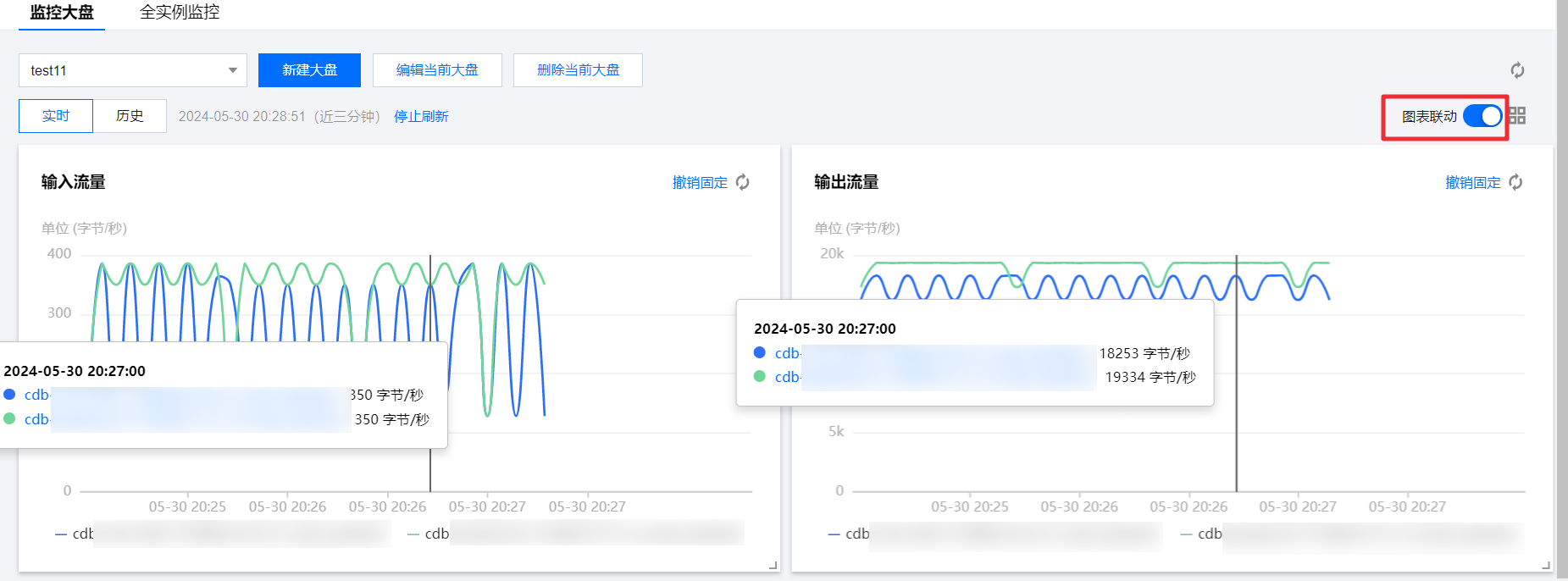

切换单列/双列显示模式
在页面右上方的图标联动右边的按钮,可切换单列模式和双列模式的显示。
双列模式
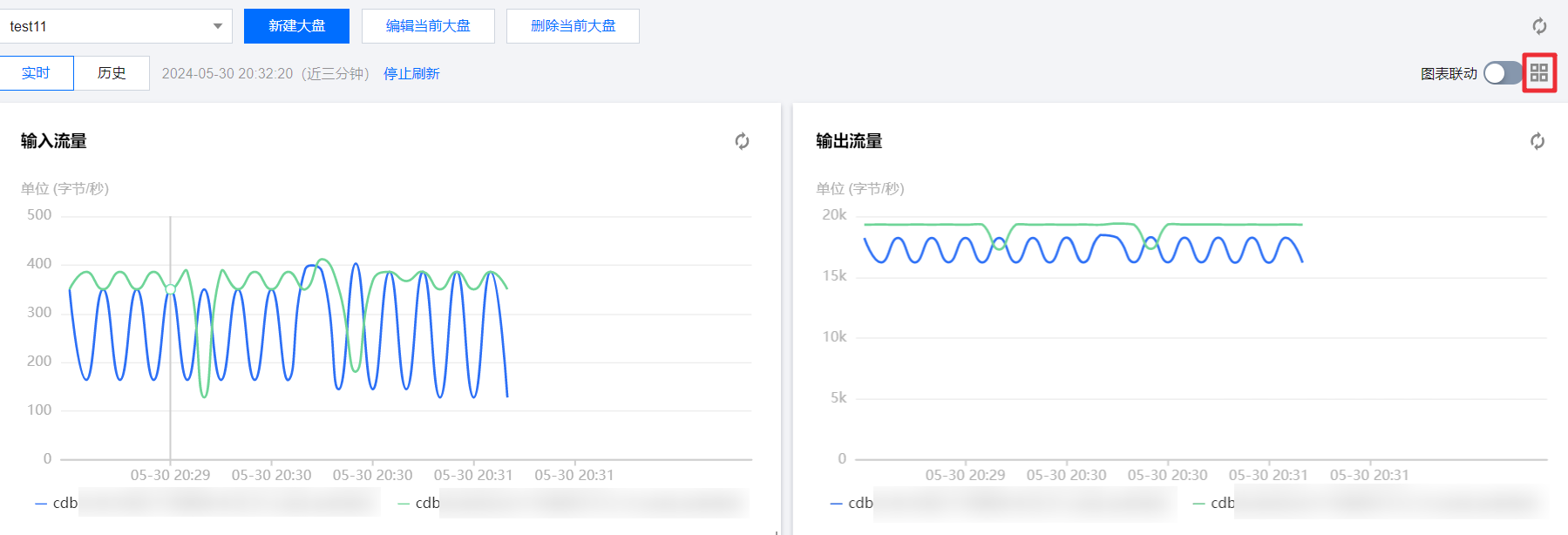

单列模式
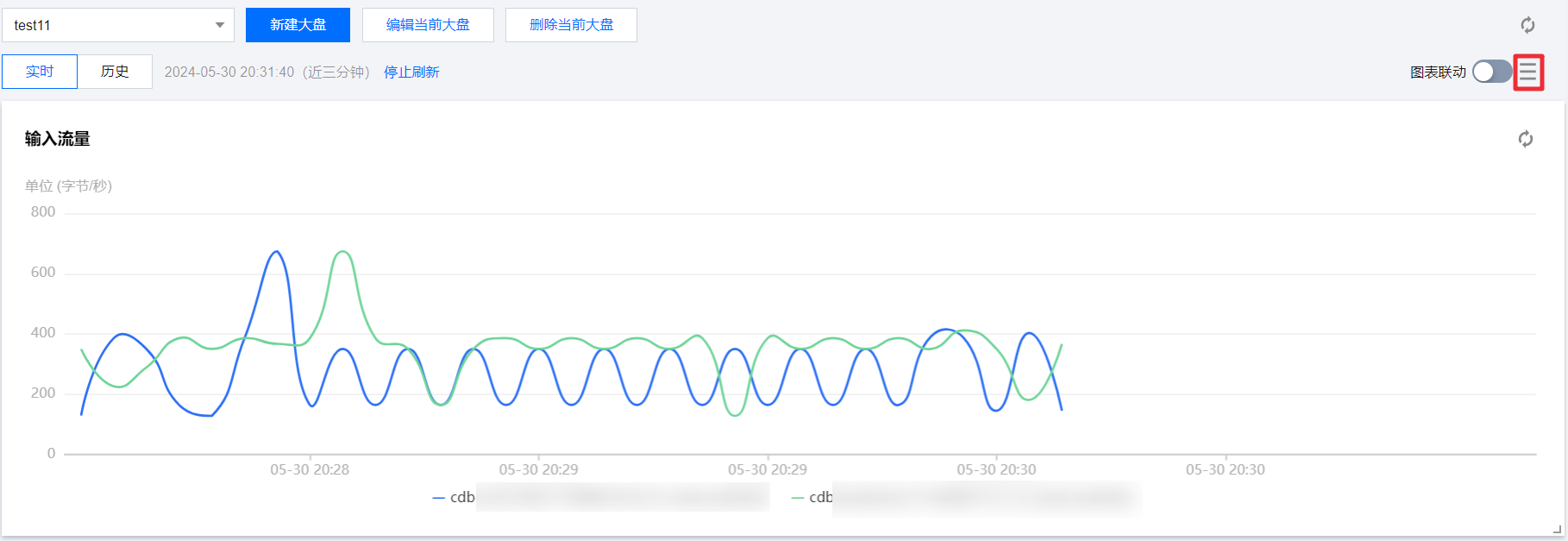

自由拖动趋势图:不同趋势图之间可以随意拖动位置,鼠标单击趋势图的边框部位即可拖动。
细粒度查看趋势图:在单个趋势图中单击某个时间点后,拖动鼠标选择待放大的时间段,细粒度展示该时间段的趋势图。

放大趋势图:拖动趋势图右下方的图标,可以放大图片,对单性能指标趋势进行更加清晰的细粒度查看。
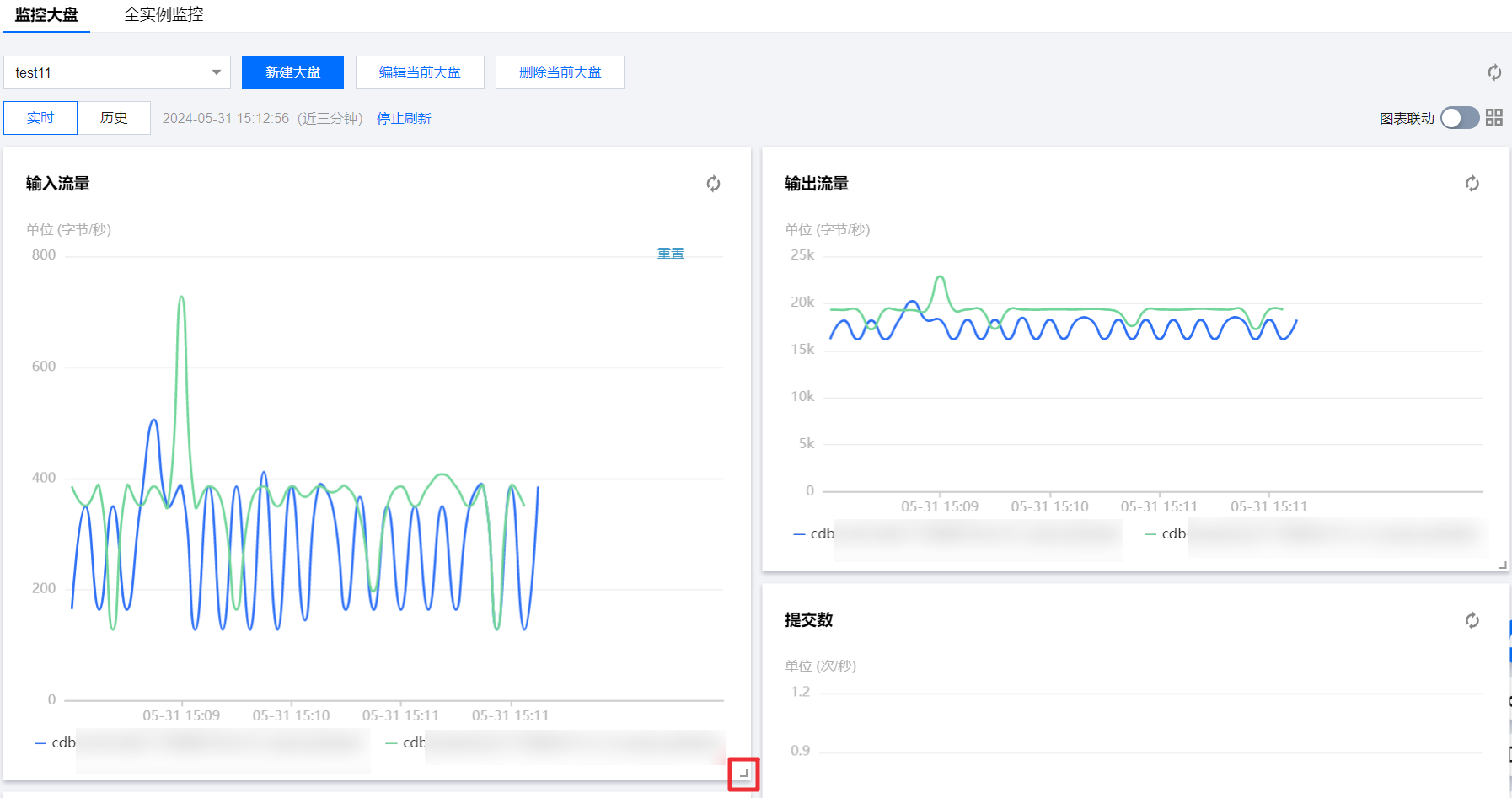

监控指标
DBbrain(MySQL)
DBbrain(MySQL)自定义监控大盘目前支持如下监控指标:
序号 | 监控指标 |
1 | bytes_received (输入流量),Bytes/秒 |
2 | bytes_sent (输出流量),Bytes/秒 |
3 | capacity (磁盘占用空间),MB |
4 | com_commit (提交数),次/秒 |
5 | com_delete (删除数),次/秒 |
6 | com_insert (插入数),次/秒 |
7 | com_replace (覆盖数),次/秒 |
8 | com_rollback (回滚数),次/秒 |
9 | com_select (查询数),次/秒 |
10 | com_update (更新数),次/秒 |
11 | connection_use_rate (连接数利用率),% |
12 | cpu_use_rate (CPU 利用率),% |
13 | created_tmp_disk_tables (磁盘临时表数量),次/秒 |
14 | created_tmp_files (临时文件数量),次/秒 |
15 | created_tmp_tables (临时表数量),次/秒 |
16 | disk_log_used (日志空间),MB |
17 | handler_commit (内部提交数),次/秒 |
18 | handler_read_rnd_next (读下一行请求数),次/秒 |
19 | handler_rollback (内部回滚数),次/秒 |
20 | innodb_buffer_pool_pages_free (InnoDB 空页数),个 |
21 | innodb_buffer_pool_pages_total (InnoDB 总页数),个 |
22 | innodb_buffer_pool_read_requests (InnoDB 逻辑读),次/秒 |
23 | innodb_buffer_pool_reads (InnoDB 物理读),次/秒 |
24 | innodb_cache_hit_rate (InnoDB 缓存命中率),% |
25 | innodb_cache_use_rate (InnoDB 缓存使用率),% |
26 | innodb_data_read (InnoDB 读取量),Byte/秒 |
27 | innodb_data_reads (InnoDB 总读取量),次/秒 |
28 | innodb_data_writes (InnoDB 总写入量),次/秒 |
29 | innodb_data_written (InnoDB 写入量),Byte/秒 |
30 | innodb_num_open_files (当前 InnoDB 打开表的数量),个 |
31 | innodb_os_file_reads (InnoDB 读磁盘数量),次/秒 |
32 | innodb_os_file_writes (InnoDB 写磁盘数量),次/秒 |
33 | innodb_os_fsyncs (InnoDB fsync数量),次/秒 |
34 | innodb_row_lock_time_avg (InnoDB 平均获取行锁时间),毫秒 |
35 | innodb_row_lock_waits (InnoDB 等待行锁次数),次/秒 |
36 | innodb_rows_deleted (InnoDB 行删除量),次/秒 |
37 | innodb_rows_inserted (InnoDB 行插入量),次/秒 |
38 | innodb_rows_read (InnoDB 行读取量),次/秒 |
39 | innodb_rows_updated (InnoDB 行更新量),次/秒 |
40 | key_blocks_unused (键缓存内未使用的块数量),个 |
41 | key_blocks_used (键缓存内使用的块数量),个 |
42 | key_cache_hit_rate (MyISAM 缓存命中率),% |
43 | key_cache_use_rate (MyISAM 缓存使用率),% |
44 | key_read_requests (键缓存读取数据块次数),次/秒 |
45 | key_reads (硬盘读取数据块次数),次/秒 |
46 | key_write_requests (数据块写入键缓冲次数),次/秒 |
47 | key_writes (数据块写入磁盘次数),次/秒 |
48 | log_capacity (日志空间),MB |
49 | master_slave_sync_distance (主从延迟距离),MB |
50 | max_connections (最大连接数),个 |
51 | memory_use (内存占用),MB |
52 | memory_use_rate (内存),% |
53 | open_files (打开文件总数),个 |
54 | opened_tables (已经打开的表数),个 |
55 | qps (QPS),次/秒 |
56 | queries (总请求数),次/秒 |
57 | query_rate (查询使用率),% |
58 | real_capacity (磁盘使用空间),MB |
59 | seconds_behind_master (主从延迟时间),秒 |
60 | select_count (查询数),次/秒 |
61 | select_scan (全表扫描数),次/秒 |
62 | slave_io_running (IO 线程状态),0-Yes, 1-No, 2-Connecting |
63 | slave_sql_running (SQL 线程状态),0-Yes, 1-No |
64 | slow_queries (慢 SQL),次 |
65 | table_locks_immediate (立即释放的表锁数),次/秒 |
66 | table_locks_waited (等待表锁次数),次/秒 |
67 | threads_connected (Connected Threads),个 |
68 | threads_created (已创建的线程数),个 |
69 | threads_running (Running Threads),个 |
70 | tps (TPS),次/秒 |
71 | volume_rate (磁盘利用率),% |
DBbrain(TDSQL-C for MySQL)
DBbrain(TDSQL-C for MySQL)自定义监控大盘目前支持如下监控指标。
序号 | 监控指标 |
1 | bytes_received (输入流量),Bytes/秒 |
2 | bytes_sent (输出流量),Bytes/秒 |
3 | ccu (ccu),Count |
4 | com_commit (提交数),个/秒 |
5 | com_delete (删除数),次/秒 |
6 | com_insert (插入数),次/秒 |
7 | com_replace (覆盖数),次/秒 |
8 | com_rollback (回滚数),Count/s |
9 | com_update (更新数),次/秒 |
10 | connection_use_rate (连接数利用率),% |
11 | cpu_use_rate (CPU 利用率),% |
12 | created_tmp_disk_tables (临时表数量),Count/s |
13 | created_tmp_files (临时文件数量),Count/s |
14 | created_tmp_tables (临时表数量),次/秒 |
15 | data_volume_usage (数据表空间使用量),MB |
16 | handler_commit (每秒事务提交的次数),次/秒 |
17 | handler_read_rnd_next (读下一行请求数),Count/s |
18 | handler_rollback (每秒事务回滚的次数),次/秒 |
19 | innodb_buffer_pool_pages_dirty (InnoDB 脏页数),Count |
20 | innodb_buffer_pool_pages_free (InnoDB 空页数),Count |
21 | innodb_buffer_pool_pages_total (InnoDB 总页数),Count |
22 | innodb_buffer_pool_read_requests (InnoDB 逻辑读),次/秒 |
23 | innodb_buffer_pool_reads (InnoDB 物理读),Count/s |
24 | innodb_buffer_pool_write_requests (InnoDB 逻辑写),次/秒 |
25 | innodb_cache_hit_rate (InnoDB 缓存命中率),% |
26 | innodb_cache_use_rate (InnoDB 缓存使用率),% |
27 | innodb_data_pending_reads (InnoDB 挂起读取数),Count |
28 | innodb_data_pending_writes (InnoDB 挂起写入数),Count |
29 | innodb_data_read (InnoDB 读取量),Bytes/s |
30 | innodb_data_reads (InnoDB 总读取量),Count/s |
31 | innodb_data_writes (InnoDB 总写入量),Count/s |
32 | innodb_data_written (InnoDB 写入量),Bytes/s |
33 | innodb_log_waits (InnoDB 日志等待写入次数),Count/s |
34 | innodb_log_write_requests (InnoDB 日志物理写请求次数),Count/s |
35 | innodb_log_writes (InnoDB 日志物理写入次数),Count/s |
36 | innodb_num_open_files (当前 InnoDB 打开表的数量),Count |
37 | innodb_os_file_reads (读磁盘数量),Count |
38 | innodb_os_file_writes (写磁盘数量),Count |
39 | innodb_os_fsyncs (InnoDB_fsyncs数),Count |
40 | innodb_row_lock_time_avg (InnoDB 平均获取行锁时间),ms |
41 | innodb_row_lock_waits (InnoDB 等待行锁次数),Count/s |
42 | innodb_rows_deleted (InnoDB 行删除量),次/秒 |
43 | innodb_rows_inserted (InnoDB 行插入量),次/秒 |
44 | innodb_rows_read (InnoDB 行读取量),次/秒 |
45 | innodb_rows_updated (InnoDB 行更新量),次/秒 |
46 | latency_delete_p95 (delete 请求耗时(P95)),us |
47 | latency_delete_p99 (delete 请求耗时(P99)),us |
48 | latency_insert_p95 (insert 请求耗时(P95)),us |
49 | latency_insert_p99 (insert 请求耗时(P99)),us |
50 | latency_other_p95 (other 请求耗时(P95)),us |
51 | latency_other_p99 (other 请求耗时(P99)),us |
52 | latency_p95 (总请求耗时(P95)),us |
53 | latency_p99 (总请求耗时(P99)),us |
54 | latency_replace_p95 (replace 请求耗时(P95)),us |
55 | latency_replace_p99 (replace 请求耗时(P99)),us |
56 | latency_select_p95 (select 请求耗时(P95)),us |
57 | latency_select_p99 (select 请求耗时(P99)),us |
58 | latency_update_p95 (update 请求耗时(P95)),us |
59 | latency_update_p99 (update 请求耗时(P99)),us |
60 | max_connections (最大连接数),个 |
61 | memory_use (内存占用),MB |
62 | memory_use_rate (内存),% |
63 | open_files (打开文件总数),Count |
64 | opened_tables (已经打开的表数),Count |
65 | qcache_hit_rate (缓存命中率),% |
66 | qcache_hits (缓存命中数),次 |
67 | qcache_use_rate (Qcache使用率),% |
68 | qps (每秒执行操作数),Count/s |
69 | select_full_join (全表扫描复合查询次数),Count/s |
70 | select_full_range_join (范围扫描复合查询次数),Count/s |
71 | select_scan (全表扫描数),次/秒 |
72 | slow_queries (慢 SQL),次 |
73 | sort_merge_passes (排序合并通过次数),Count/s |
74 | storage_use (存储使用量),MB |
75 | storage_use_rate (存储使用率),% |
76 | table_locks_immediate (立即释放的表锁数),Count/s |
77 | table_locks_waited (等待表锁次数),Count/s |
78 | table_open_cache_hits (表打开缓存命中数),Count/s |
79 | table_open_cache_misses (表打开缓存未命中数),Count/s |
80 | threads_connected (Connected Threads),个 |
81 | threads_created (已创建的线程数),个 |
82 | threads_running (Running Threads),个 |
83 | tmp_volume_usage (临时表空间使用量),MB |
84 | tps (每秒执行事务数),Count/s |
85 | undo_volume_usage (undo表空间使用量),MB |
DBbrain(MariaDB、TDSQL MySQL)
DBbrain(MariaDB、TDSQL MySQL)自定义监控大盘目前支持如下监控指标:
序号 | 监控指标 |
1 | binlog_disk_available (日志磁盘可用量),MB |
2 | commit_total (提交数),次/秒 |
3 | conn_max (最大连接数),个 |
4 | conn_usage_rate (连接使用率),% |
5 | cpu_usage_rate (CPU 利用率),% |
6 | data_disk_available (数据磁盘可用量),MB |
7 | data_disk_used (数据磁盘使用量),MB |
8 | data_disk_used_rate (数据磁盘利用率),% |
9 | delete_total (删除数),次/秒 |
10 | innodb_buffer_pool_read_requests (InnoDB 逻辑读),次/秒 |
11 | innodb_buffer_pool_reads (InnoDB 物理读),次/秒 |
12 | innodb_rows_deleted (InnoDB 行删除量),次/秒 |
13 | innodb_rows_inserted (InnoDB 行插入量),次/秒 |
14 | innodb_rows_read (InnoDB 行读取量),次/秒 |
15 | innodb_rows_updated (InnoDB 行更新量),次/秒 |
16 | insert_total (插入数),次/秒 |
17 | long_query (慢查询数),次 |
18 | replace_total (覆盖数),次/秒 |
19 | request_total (总请求数),次/秒 |
20 | rollback_total (回滚数),次/秒 |
21 | select_total (查询数),次/秒 |
22 | threads_connected (Connected Threads),个 |
23 | threads_running_count (Running Threads),个 |
24 | update_total (更新数),次/秒 |
DBbrain(Redis)
DBbrain(Redis)自定义监控大盘目前支持如下监控指标。
序号 | 监控指标 |
1 | cmd_big_value (大Value请求),次/秒 |
2 | cmd_err (执行错误),次/秒 |
3 | cmd_hits (读请求命中),次 |
4 | cmd_hits_ratio (读请求命中率),% |
5 | cmd_key_count (Key请求数),次/秒 |
6 | cmd_mget (Mget请求数),次/秒 |
7 | cmd_miss (读请求Miss),次 |
8 | cmd_other (其他请求),次/秒 |
9 | cmd_read (读请求),次/秒 |
10 | cmd_slow (慢查询),次 |
11 | cmd_write (写请求),次/秒 |
12 | commands (总请求),次/秒 |
13 | connections (连接数),个 |
14 | connections_util (连接使用率),% |
15 | cpu_max_util (节点最大 CPU 使用率),% |
16 | cpu_util (CPU 使用率),% |
17 | evicted (key驱逐数),次 |
18 | expired (key过期数),次 |
19 | in_bandwidth_util (入流量使用率),% |
20 | in_flow (入流量),MBit/s |
21 | in_flow_limit (入流量限流触发),次 |
22 | keys (Key总个数),次 |
23 | latency_avg (平均执行时延),ms |
24 | latency_max (最大执行时延),ms |
25 | latency_other (其他命令平均时延),ms |
26 | latency_p99 (P99执行时延),ms |
27 | latency_read (读平均时延),ms |
28 | latency_write (写平均时延),ms |
29 | mem_max_util (节点最大内存使用率),% |
30 | mem_used (内存使用量),MB |
31 | mem_util (内存使用率),% |
32 | out_bandwidth_util (出流量使用率),% |
33 | out_flow (出流量),MBit/s |
34 | out_flow_limit (出流量限流触发),次 |
DBbrain(MongoDB)
DBbrain(MongoDB)自定义监控大盘目前支持如下监控指标。
序号 | 监控指标 |
1 | 100ms (100ms以上的请求数),次 |
2 | 100ms_aggregates (100ms以上的aggregate请求数),次 |
3 | 100ms_commands (100ms以上的command请求数),次 |
4 | 100ms_counts (100ms以上的count请求数),次 |
5 | 100ms_deletes (100ms以上的delete请求数),次 |
6 | 100ms_getmores (100ms以上的getmore请求数),次 |
7 | 100ms_inserts (100ms以上的insert请求数),次 |
8 | 100ms_reads (100ms以上的read请求数),次 |
9 | 100ms_updates (100ms以上的update请求数),次 |
10 | 10ms (10ms-50ms请求数),次 |
11 | 10ms_aggregates (10ms-50ms的aggregate请求数),次 |
12 | 10ms_commands (10ms-50ms的command请求数),次 |
13 | 10ms_counts (10ms-50ms的count请求数),次 |
14 | 10ms_deletes (10ms-50ms的delete请求数),次 |
15 | 10ms_getmores (10ms-50ms的getmore请求数),次 |
16 | 10ms_inserts (10ms-50ms的insert请求数),次 |
17 | 10ms_reads (10ms-50ms的read请求数),次 |
18 | 10ms_updates (10ms-50ms的update请求数),次 |
19 | 50ms (50ms-100ms的请求数),次 |
20 | 50ms_aggregates (50ms-100ms的aggregate请求数),次 |
21 | 50ms_commands (50ms-100ms的command请求数),次 |
22 | 50ms_counts (50ms-100ms的count请求数),次 |
23 | 50ms_deletes (50ms-100ms的delete请求数),次 |
24 | 50ms_getmores (50ms-100ms的getmore请求数),次 |
25 | 50ms_inserts (50ms-100ms的insert请求数),次 |
26 | 50ms_reads (50ms-100ms的read请求数),次 |
27 | 50ms_updates (50ms-100ms的update请求数),次 |
28 | aggregates (aggregate请求个数),次 |
29 | avg_aggregate_ms (aggregate请求平均延迟),ms |
30 | avg_all_requests_ms (所有请求的平均延迟),ms |
31 | avg_command_ms (command请求平均延迟),ms |
32 | avg_count_ms (count请求平均延迟),ms |
33 | avg_delete_ms (delete请求平均延迟),ms |
34 | avg_getmore_ms (getmore请求平均延迟),ms |
35 | avg_insert_ms (insert请求平均延迟),ms |
36 | avg_read_ms (read请求平均延迟),ms |
37 | avg_update_ms (update请求平均延迟),ms |
38 | commands (command请求个数),次 |
39 | conn (连接数),个 |
40 | connper (连接数百分比),% |
41 | counts (count请求数),次 |
42 | cpuusage (集群最大 CPU 使用率),% |
43 | deletes (delete请求个数),次 |
44 | disk (磁盘使用量),MB |
45 | diskusage (磁盘使用百分比),% |
46 | getmores (getmore请求数),次 |
47 | inserts (insert请求个数),次 |
48 | memory (内存使用量),MB |
49 | memusage (内存使用百分比),% |
50 | netin (网络入流量Byte),Bytes |
51 | netout (网络出流量Byte),Bytes |
52 | oplogreservedtime (oplog保留时间(小时)),h |
53 | qps (QPS),次/秒 |
54 | reads (read请求个数),次 |
55 | success (成功处理的请求数),次 |
56 | syncdelayseconds (只读实例同步延迟),s |
57 | syncstatus (只读实例同步状态) |
58 | updates (update请求个数),次 |
DBbrain(自建 MySQL)
DBbrain(自建 MySQL)自定义监控大盘目前支持如下监控指标:
序号 | 监控指标 | agent 接入 | 直连接入 |
1 | bytes_received (输入流量),Bytes/秒 | ✓ | ✓ |
2 | bytes_sent (输出流量),Bytes/秒 | ✓ | ✓ |
3 | capacity (磁盘占用空间),MB | ✓ | × |
4 | com_commit (提交数),次/秒 | ✓ | ✓ |
5 | com_delete (删除数),次/秒 | ✓ | ✓ |
6 | com_insert (插入数),次/秒 | ✓ | ✓ |
7 | com_replace (覆盖数),次/秒 | ✓ | ✓ |
8 | com_rollback (回滚数),次/秒 | ✓ | ✓ |
9 | com_select (查询数),次/秒 | ✓ | ✓ |
10 | com_update (更新数),次/秒 | ✓ | ✓ |
11 | connection_use_rate (连接数利用率),% | ✓ | ✓ |
12 | cpu_use_rate (CPU 利用率),% | ✓ | × |
13 | created_tmp_disk_tables (磁盘临时表数量),次/秒 | ✓ | ✓ |
14 | created_tmp_files (临时文件数量),次/秒 | ✓ | ✓ |
15 | created_tmp_tables (临时表数量),次/秒 | ✓ | ✓ |
16 | handler_commit (内部提交数),次/秒 | ✓ | ✓ |
17 | handler_read_rnd_next (读下一行请求数),次/秒 | ✓ | ✓ |
18 | handler_rollback (内部回滚数),次/秒 | ✓ | ✓ |
19 | innodb_buffer_pool_pages_free (InnoDB 空页数),个 | ✓ | ✓ |
20 | innodb_buffer_pool_pages_total (InnoDB 总页数),个 | ✓ | ✓ |
21 | innodb_buffer_pool_read_requests (InnoDB 逻辑读),次/秒 | ✓ | ✓ |
22 | innodb_buffer_pool_reads (InnoDB 物理读),次/秒 | ✓ | ✓ |
23 | innodb_data_read (InnoDB 读取量),Byte/秒 | ✓ | ✓ |
24 | innodb_data_reads (InnoDB 总读取量),次/秒 | ✓ | ✓ |
25 | innodb_data_writes (InnoDB 总写入量),次/秒 | ✓ | ✓ |
26 | innodb_data_written (InnoDB 写入量),Byte/秒 | ✓ | ✓ |
27 | innodb_num_open_files (当前 InnoDB 打开表的数量),个 | ✓ | ✓ |
28 | innodb_row_lock_time_avg (InnoDB 平均获取行锁时间),毫秒 | ✓ | ✓ |
29 | innodb_row_lock_waits (InnoDB 等待行锁次数),次/秒 | ✓ | ✓ |
30 | innodb_rows_deleted (InnoDB 行删除量),次/秒 | ✓ | ✓ |
31 | innodb_rows_inserted (InnoDB 行插入量),次/秒 | ✓ | ✓ |
32 | innodb_rows_read (InnoDB 行读取量),次/秒 | ✓ | ✓ |
33 | innodb_rows_updated (InnoDB 行更新量),次/秒 | ✓ | ✓ |
34 | key_blocks_unused (键缓存内未使用的块数量),个 | ✓ | ✓ |
35 | key_blocks_used (键缓存内使用的块数量),个 | ✓ | ✓ |
36 | key_read_requests (键缓存读取数据块次数),次/秒 | ✓ | ✓ |
37 | key_reads (硬盘读取数据块次数),次/秒 | ✓ | ✓ |
38 | key_write_requests (数据块写入键缓冲次数),次/秒 | ✓ | ✓ |
39 | key_writes (数据块写入磁盘次数),次/秒 | ✓ | ✓ |
40 | log_capacity (日志空间),MB | ✓ | × |
41 | max_connections (最大连接数),个 | ✓ | ✓ |
42 | memory_use (内存占用),MB | ✓ | × |
43 | memory_use_rate (内存),% | ✓ | × |
44 | open_files (打开文件总数),个 | ✓ | ✓ |
45 | opened_tables (已经打开的表数),个 | ✓ | ✓ |
46 | qps (QPS),次/秒 | ✓ | ✓ |
47 | queries (总请求数),次/秒 | ✓ | ✓ |
48 | real_capacity (磁盘使用空间),MB | ✓ | × |
49 | select_count (查询数),次/秒 | ✓ | ✓ |
50 | select_scan (全表扫描数),次/秒 | ✓ | ✓ |
51 | slow_queries (慢 SQL),次 | ✓ | ✓ |
52 | table_locks_immediate (立即释放的表锁数),次/秒 | ✓ | ✓ |
53 | table_locks_waited (等待表锁次数),次/秒 | ✓ | ✓ |
54 | threads_connected (Connected Threads),个 | ✓ | ✓ |
55 | threads_created (已创建的线程数),个 | ✓ | ✓ |
56 | threads_running (Running Threads),个 | ✓ | ✓ |
57 | tps (TPS),次/秒 | ✓ | ✓ |
58 | volume_rate (磁盘利用率),% | ✓ | × |
文档反馈

